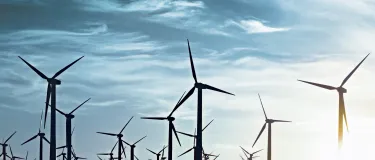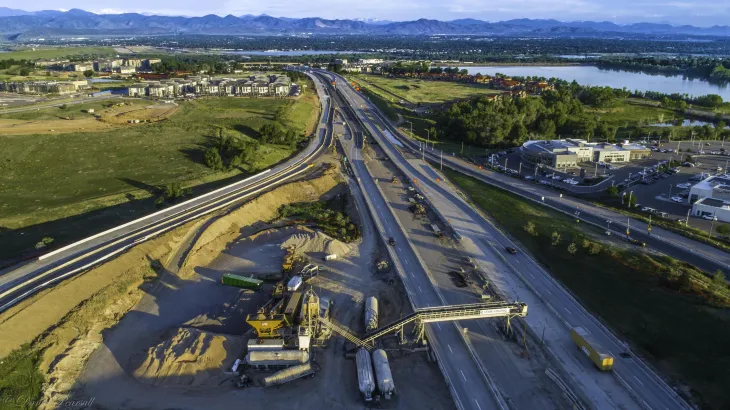Building Strong Foundations in Wind Energy with OneCem® Portland Limestone Cement
The United States is home to one of the largest and fastest-growing wind markets in the world. From January through December of 2019, 300.1 terawatt-hours were generated by wind power, or 7.29% of all generated electrical energy in the country. Moving forward, the wind industry remains a critical part of our nation’s energy strategy to cut carbon emissions and diversify our energy economy.
Colorado is the country’s seventh largest wind-producing state. In 2004, the state passed the first Renewable Energy Standard in the nation, spurring the development of hundreds of new renewable energy projects. Between 2005 and 2016, wind energy increased from 1.5% to 17.3% of electricity generated in Colorado, accounting for more than 4% of wind generation in the country.
The Challenge
In eastern Colorado, wind energy is rapidly taking hold and bringing considerable economic and environmental benefits with it. Located on a combination of pasture and wheat fields in Kit Carson and Cheyenne Counties, the new Crossing Trails Wind Farm is providing farm owners with a stable cash crop through lease payments with minimal impact on current land use. Crossing Trails’ 25 Vestas wind turbines are generating 104 megawatts of clean electricity to power more than 50,000 Colorado homes annually.
As with all projects in rural areas, the construction teams working on the Crossing Trails Wind Farm faced significant challenges. There were nine miles of access roads to build and stabilize on dry sandy soil, more than 16,000 cubic yards of concrete to place for turbine foundations and a large volume of construction materials to source and deliver to the remote jobsite. Ensuring high-performance concrete placements—by addressing sulfate resistance, alkali silica reactivity (ASR), and heat of hydration concerns—and achieving high standards in sustainable construction practices were critical to success.
The Solution
To meet the demanding building performance requirements of the Crossing Trails Wind Farm, while minimizing environmental impact, Holcim recommended and supplied 6,000 tons of OneCem Portland Limestone Cement (PLC) for stabilizing the soil base of the access roads and constructing the concrete foundations supporting the 345-foot-tall wind turbines. OneCem, part of the Envirocore™ Series, has been used in Colorado projects since 2008 and offers the same level of performance as Type I/II cements. Because it uses less clinker, carbon dioxide emissions are reduced by up to 10 percent per ton of cement.
Project plans originally called for the construction of 12-inch aggregate access roads but aggregate is difficult to source and expensive in this part of Colorado. Based on speed of construction requirements, aggregate accessibility and economic considerations, a decision was made to build the roads starting with a 12-inch layer of cement to stabilize the soil and topping that off with a 4-inch layer of aggregate. In switching to the cement stabilization approach, the project team reduced aggregate needs by two-thirds while achieving specified geotechnical compressibility and strength performance properties.
Construction started with bulldozers removing vegetation and topsoil to rough in the 16-foot-wide roads. Spreaders next applied a 12-inch treatment layer of cement to stabilize the soil, which was then capped with 4-inch aggregate wearing course. This provided a stable base for supporting the heavy construction equipment needed to build the turbines. According to Bryan Ray at Allstates Pavement Recycling & Stabilization, outstanding logistics planning was critical as there were no cement storage silos on site and the Holcim cement plant was 160 miles away. “We needed a reliable on-time daily supply of 350 tons of cement and the Holcim delivery trucks were arriving like clockwork, 7 days a week, to load our spreaders and keep the 12-day project schedule on track.”
With the access roads complete, the team set up two portable ready-mix batch plants to produce approximately 16,000 cubic yards of concrete for the 25 wind turbine foundations. The concrete mixes relied on 3,500 tons of OneCem, as well as 20 percent Class F fly ash to mitigate potential ASR issues. Specified 28-day strengths were 5,000 psi for the base and 6,000 psi for the pedestal.
Each 62-foot-diameter, 13-foot-high turbine foundation required 642 cubic yards of concrete. The multi-step construction process started with placing 40 cubic yards of concrete for a four-inch mud matte, rebar was then inserted, 560 cubic yards of concrete were poured next for the base, and the job was completed with pouring 42 cubic yards of concrete for the pedestal. The huge bolts that fasten to the tower were embedded into the upper section of the concrete.
Controlling heat build-up was a primary consideration with the mass concrete pours and the Holcim technical support team relied on embedded thermocouples in the concrete to monitor temperature data. “We had zero thermal cracking in the concrete foundations, met high sulfate resistance and ASR mix design performance requirements, and consistently hit our specified 28-day strengths in 7 to 10 days,” said Corey Emerson, project manager for Kansas-based Hammerson Ready Mix. “This early strength attainment is a great benefit for wind-farm projects, as it allows you to backfill the foundations sooner and complete the work ahead of schedule.”
The Results
With the costs of renewable energy falling and concerns about climate-changing emissions increasing, the Crossing Trails Wind Farm offers broad and lasting benefits to Colorado’s environment, economy and health of residents.
Installed in 2020, the 25 state-of-the-art wind turbines are generating 104 megawatts of clean electricity to 50,000 rural homes, as well as saving more than 184 million gallons of water each year. And with 6,000 tons of OneCem used to make it all happen, the reduced carbon footprint of the Crossing Trails Wind Farm in environmentally minded Colorado is substantial.
In what is largely farm country, the homegrown wind power will be another crop from the fertile lands of eastern Colorado, blowing all year long and providing clean power for generations to come.
Manufactured with quality limestone, OneCem uses less clinker than the traditional portland cement and reduces CO2 emissions by five to ten percent per ton of cement.







